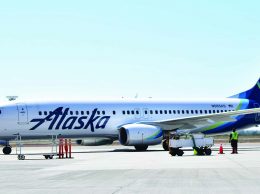Dubroff: Future of regional flights up in the air as Frontier drops Santa Barbara
IN THIS ARTICLE
- Columns Topic
- Henry Dubroff Author
By Henry Dubroff Friday, September 26th, 2014

Henry Dubroff
When the A-319 Airbus jets with animals painted on their tails first landed at Santa Barbara Airport in June 2010, business travelers on the Central Coast breathed a big sigh of relief.
Denver-based Frontier Airlines promised a full-sized airplane, plenty of perks for business flyers, DirecTV and dozens of inexpensive daily connections to the East Coast. It meant no more two-hour flights packed like sardines into United Ariline’s 50-seat regional jets. No more leg cramps, frozen feet or white knuckle landings at Denver International Airport.
As a business owner who travels 30-plus weeks a year, I was delighted to be on that first flight. But the promise didn’t last very long. Two flights a day were reduced to one afternoon departure as Frontier went through a debt restructuring and a sale. As the new owners — a private equity firm which had major investments in low-budget Spirit Airlines — took over, things changed dramatically.
Benefits for Summit members began to evaporate. Over the summer, Frontier’s flights were slashed to four times a week — hardly the sort of schedule that can attract business flyers. In September, Frontier announced an ultra-low fare strategy that further diminished its luster for business flyers who now were going to have to pay for checked bags and just about everything else.
As the Business Times first reported, Frontier Airlines is pulling out of Santa Barbara indefinitely. Although the airline says it may return with seasonal service over the summer, the promise for business flyers is pretty much broken.
What’s happening to Frontier flights on the Central Coast is not entirely unique. Frontier’s ultra-low-fare model is really aimed at heavily trafficked routes that lend themselves to a volume game.
But the departure of a competitor on the Denver-Santa Barbara route signals big changes that are happening in commercial aviation — changes that will require communities to adapt if they want to expand air service.
First, there is the rise of mini-monopolies. United Airlines now has a lock on service from Santa Barbara, San Luis Obispo and Santa Maria to Los Angeles and from Santa Barbara and San Luis to San Francisco.
US Airways is the sole airline serving Phoenix from Santa Barbara and SLO, while Allegiant has the Santa Maria-Las Vegas route and Alaska Airlines has a lock on Portland-Seattle service. This means that, increasingly, there is only one option for getting from here to there no matter where you start on the Central Coast.
Rising fuel costs and consolidation — most recently the combination of US Airways and American Airlines — means that larger cities are getting more flights and smaller communities are losing ground. What this means is that thoughts about a San Luis Obispo to Denver flight are pretty much up in the air for now.
Second, there is a palpable shift to alternatives as business flyers look for something other than private jets for convenient service to destinations. Venture-backed Surf Air, pioneer of the all-you-can-fly monthly membership for service on a 12-seat Pilatus aircraft, has added Tahoe and Las Vegas to destinations that include Santa Barbara, Los Angeles and the Bay Area. SLO is reportedly on Surf Air’s “future destination” list.
One executive I spoke with recently said he leases time on a privately owned Pilatus prop jet to fly from Camarillo to Arizona and the Central Valley, essentially creating his own informal air route.
Third, it will take creativity to expand the pie of offerings from commercial carriers. San Luis Obispo and Santa Maria have been engaged in a spirited competition for air service, with both targeting Denver. But the future may lie in the two cities creating a joint powers agreement and co-marketing themselves in a way that allows them to coordinate schedules and incentives. You might call it creating a monopoly to deal with a monopoly — and that’s what it may take to get an airline’s attention.
The bottom line is that when it comes to air travel, our relatively dispersed and for the most part growth-adverse communities are going to pay a price for the stagnant population gains that comes with anti-development politics.
Until the current aviation environment changes, there isn’t going to be a magic solution that brings cheap, frequent flights to the region. Until there are dramatic changes in aircraft fuel efficiency or in the demand for services, business flyers appear to be pretty much stuck with the status quo.
That means sore knees, aching backs, coping with fog in San Francisco or traffic holds at LAX. Don’t forget to pack plenty of Advil.
• Contact Editor Henry Dubroff at [email protected].











